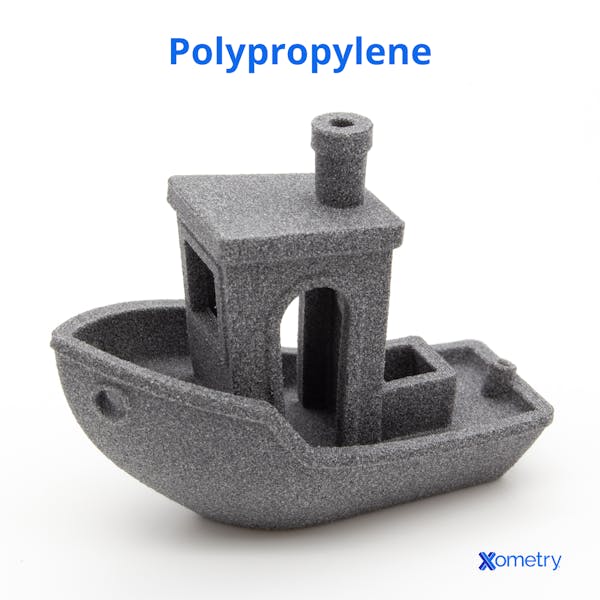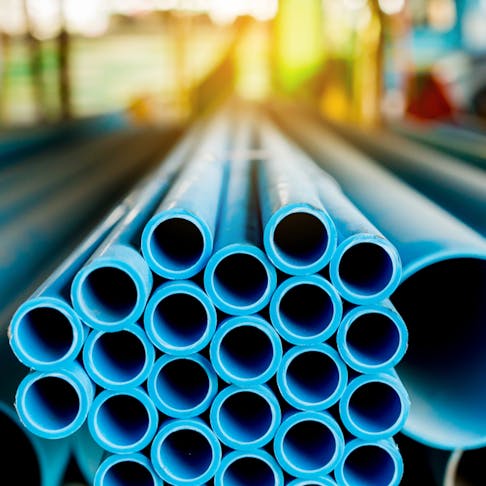Polypropylene (PP) and polyvinyl chloride (PVC) are two of the most commonly used thermoplastics in the world today. As plastics, both PP and PVC are synthesized from petroleum. Both can be used to fabricate various products using thermoplastic manufacturing methods such as injection molding, extrusion, and thermoforming. PP is most often used in the packaging industry. It is also commonly used to make plastic parts in electrical devices, machinery, automobiles, and consumer products. On the other hand, PVC is most often used for plumbing in the construction industry, and as building and electrical insulation. This article will compare polypropylene vs PVC, and discuss the differences between these two materials, to help you pick the right material for your project.
What is Polypropylene?
Polypropylene, commonly referred to as PP in industry, is a thermoplastic material composed of propylene monomers. PP is produced by several different polymer manufacturing companies and is sold under such brand names as Edgetek® by Avient and INSPIRE™ by Dow Chemical.
First synthesized in 1951 by scientists Paul Hogan and Robert Banks at Phillips Petroleum, PP use grew quickly. This can be attributed to PP’s excellent chemical resistance, making it a great material for packaging many types of liquids. Additionally, its elasticity, toughness, lightweight, and fatigue resistance make it an excellent substitute for some components previously made of metal. PP also has excellent electrical insulation characteristics. This characteristic makes it perfect for components such as capacitors and wire insulation. Finally, PP is 100% recyclable. It is a more attractive material to environmentally-conscious companies in terms of sustainability.
Today, PP is most commonly used in the packaging industry to make objects such as casings for a number of products and foods. PP is also often used in the medical industry for syringes, Petri dishes, and specimen bottles. For more information, read our guide on Polypropylene Plastic.

What is PVC?
Polyvinyl chloride, more commonly referred to as PVC (or simply “vinyl”), is a popular thermoplastic material used in several industries. It was first synthesized in 1872 and commercially produced in the 1920s by the B.F. Goodrich Company. PVC has been invented before other commercially viable plastics that are often used today.
PVC comes in two forms: an unplasticized, rigid form and a flexible form. Some notable characteristics of PVC include its: high density (PVC is much denser than other plastics), relatively lightweight compared to metals, hardness and durability, outstanding tensile strength, and resistance to environmental and chemical degradation.
The main differences between the rigid and flexible forms of PVC are in their hardness and tensile strength. Rigid PVC is a strong but brittle material commonly used for high-strength pipes in the plumbing and agriculture industries. Flexible (plasticized) PVC has more elasticity than rigid PVC and is commonly used in the construction industry for insulation on electrical wires or exterior walls in the form of vinyl siding.

Polypropylene vs. PVC: Applications and Uses
Polypropylene and PVC each have myriads of unique uses across many industries. In many cases, one material or the other is better suited to the applications, though in some cases, PP and PVC can be used interchangeably. Polypropylene’s exclusive applications include:
- Food and beverage packaging
- Consumer products such as toys and various kitchen appliances.
- Automotive components such as car bumpers, battery housings, interior trim, etc.
PVC’s exclusive applications are:
- Pipes and fittings for the construction and plumbing industries.
- Windows and siding for the construction industry.
Listed below are some of the applications where PP and PVC can both be used:
- Insulation for electrical wires.
- Textiles (when spun as fibers) in the form of tote bags, rugs, mats, and clothing.
- Medical packaging and containers, including specimen and pill bottles, IV bags, Petri dishes, etc.
Polypropylene vs. PVC: Physical Properties
The physical properties of polypropylene and PVC are not significantly different. This is why the two materials can be used in many of the same applications. Table 1 below shows a head-to-head comparison of the physical properties of the two materials:
| Property | Polypropylene | PVC |
|---|---|---|
Property Chemical Resistance | Polypropylene Excellent chemical resistance — dilute bases and acids do not react with PP | PVC Excellent chemical resistance - like PP, PVC does not react with acids or dilute bases |
Property Tensile Strength | Polypropylene 25-40 MPa | PVC 34-62 MPa (Rigid PVC) 7-25 MPa (Flexible PVC) |
Property Impact Tolerance | Polypropylene High impact resistance | PVC Both rigid and flexible PVC have low impact strength compared to PP. |
Property Water Absorption (% weight increase after soaking in water for 24 hrs) | Polypropylene 0.01% | PVC 0.04-0.40% (rigid) 0.20-1.00% (flexible) |
Property Surface Hardness | Polypropylene 92 HRR (Rockwell R) | PVC 114 HRR (Rockwell R) |
Property Operating Temperature | Polypropylene <180 °F | PVC <140-203 °F (depending on additives) |
Property Melting Temperature | Polypropylene 327 °F | PVC 212-500 °F (depending on additives to PVC) |
Polypropylene vs. PVC: Recyclability and Sustainability
Both polypropylene (PP) and PVC are recyclable, but different methods are used to recycle them. Being plastics, however, neither PP nor PVC is sustainable for the environment. However, PP is 100% recyclable. It can be ground, then melted and reused in another application many times over. PVC, however, is less easily recyclable than PP. Due to the high chlorine content in PVC, as well as other hazardous additives, PVC recycling requires additional processes. There are two methods of recycling PVC: mechanical recycling and feedstock recycling. Mechanical recycling, like PP recycling, consists of grinding PVC into small granules and melting the material to form new products. PVC particulates must be separated from other plastics due to the presence of additional additives. Feedstock recycling uses pyrolysis and hydrolysis to convert the PVC back into its constituent components.
Polypropylene vs. PVC: Cost
Because of their relatively low cost compared to other thermoplastics, polypropylene and PVC are two of the most widely used thermoplastics in the world today. PP costs roughly $0.27 per kilogram, while PVC costs roughly $0.28 per kilogram. Flexible PVC will be slightly more expensive than rigid PVC due to the processes and labor needed to plasticize it.
Alternative Materials to Polypropylene and PVC
Nylon and ABS are two alternative materials that have similar characteristics to both polypropylene and PVC. Nylon has excellent resistance to environmental degradation, great electrical insulating properties — making it ideal for use in electrical cables and components — and similar mechanical strength. The tensile strength and impact resistance of ABS are similar to those of both PP and PVC. However, ABS degrades in direct sunlight. Regardless, ABS can be used to make many of the same products that are made from PP and PVC, provided that outdoor applications are carefully designed to take into account the UV light susceptibility of ABS.
Summary
This article presented polypropylene and PVC, explained each of them, and discussed their various applications and benefits. To learn more about polypropylene and PVC, contact a Xometry representative.
Xometry provides a wide range of manufacturing capabilities and other value-added services for all of your prototyping and production needs. Visit our website to learn more or to request a free, no-obligation quote.
Copyright and Trademark Notices
- Edgetek® is a registered trademark of Avient Corporation.
- INSPIRE™ is a registered trademark of Doe Chemical Company.
Disclaimer
The content appearing on this webpage is for informational purposes only. Xometry makes no representation or warranty of any kind, be it expressed or implied, as to the accuracy, completeness, or validity of the information. Any performance parameters, geometric tolerances, specific design features, quality and types of materials, or processes should not be inferred to represent what will be delivered by third-party suppliers or manufacturers through Xometry’s network. Buyers seeking quotes for parts are responsible for defining the specific requirements for those parts. Please refer to our terms and conditions for more information.

